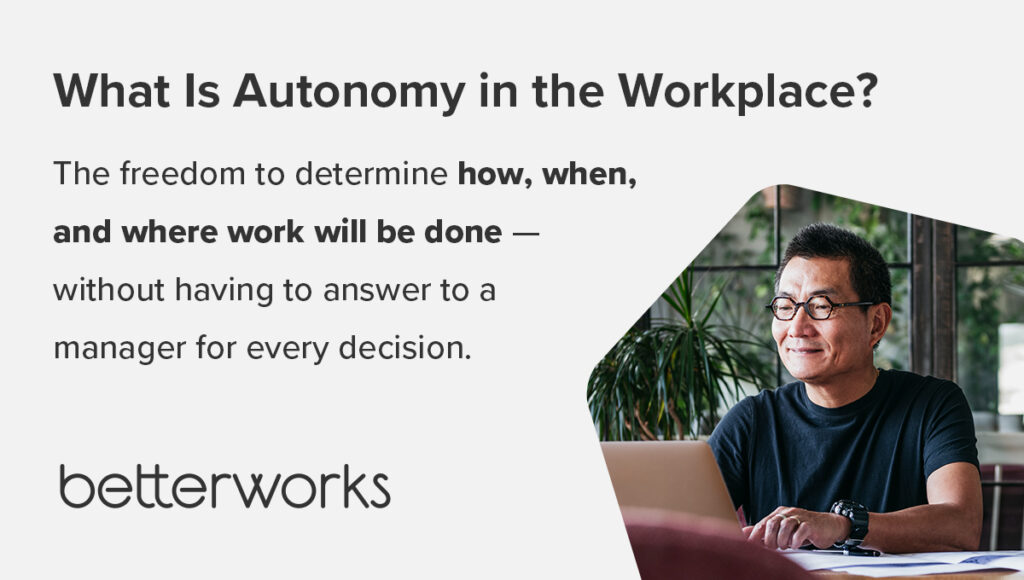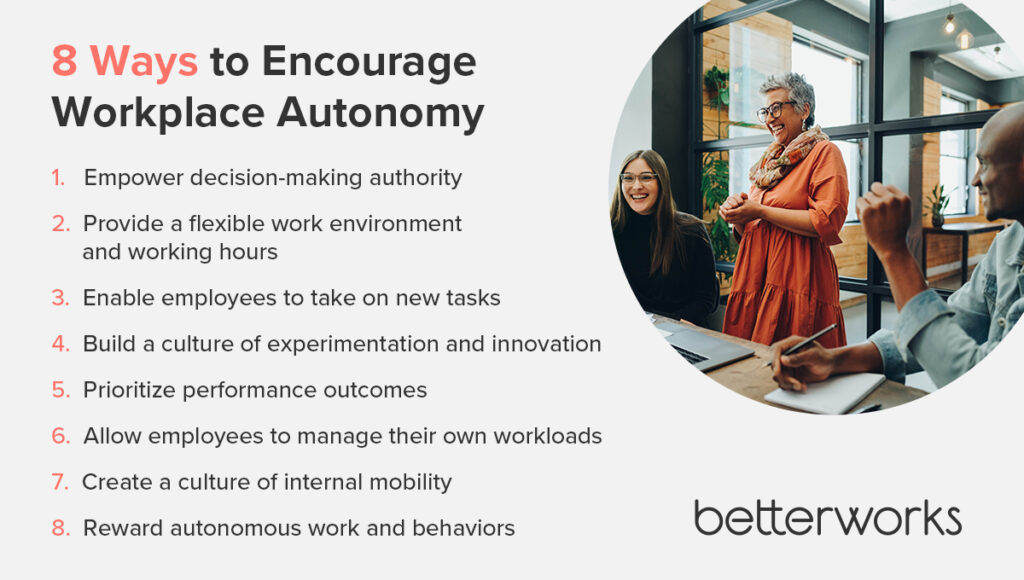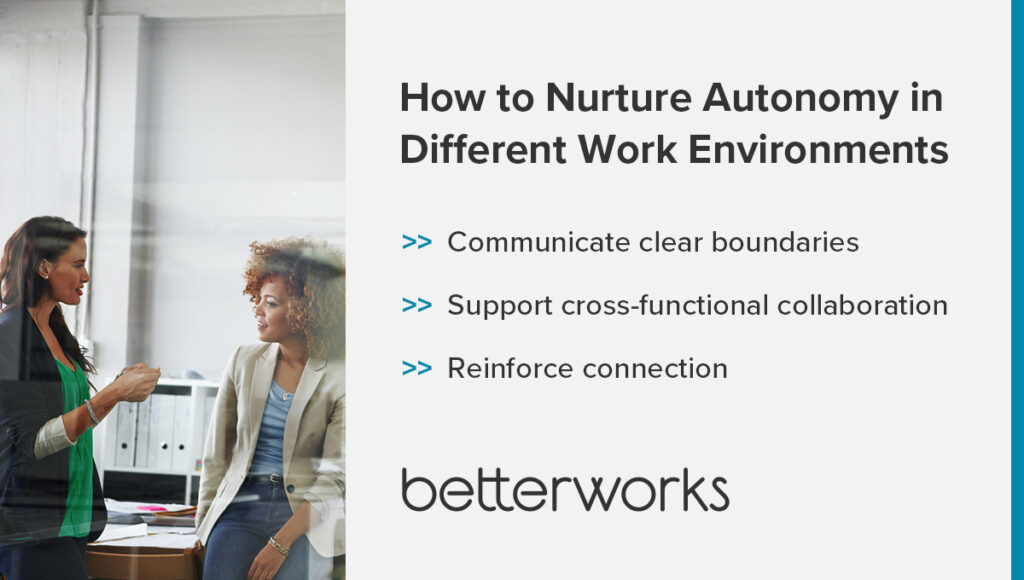- Workplace autonomy: What it is — and isn’t
- The impact of autonomy on employee engagement
- 8 tips for encouraging autonomy at work
- Empower decision-making authority
- Provide a flexible work environment and working hours
- Enable employees to take on new tasks
- Build a culture of experimentation and innovation
- Prioritize performance outcomes
- Allow employees to manage their own workloads
- Create a culture of internal mobility
- Reward autonomous work and behaviors
- How to nurture autonomy in different work environments
- Autonomy in the workplace: Your ticket to better team performance
Allowing employees to take ownership of their work encourages an environment of collaboration and creativity that drives the business forward. That’s why cultivating autonomy in the workplace should be an HR priority.
In the past, employers have avoided employee autonomy for the same reason they doubled down on rules and regulations: A belief that orders must come from the top for a business to be successful. Today, many organizations have embraced shared accountability throughout the workforce — and autonomy plays an important part in this approach.
Discover what workplace autonomy is, why it matters, and how to cultivate it in your organization.
Workplace autonomy: What it is — and isn’t
Workplace autonomy is the freedom given to employees to make their own decisions and take ownership of their work. In this setup, employees have more control over how, when, and where work gets done. They spend less time clearing decisions with their manager or waiting for orders.
Autonomy allows employees to take more responsibility for their work while acting in the best interests of the organization. They can propose ideas and make thoughtful decisions that benefit the business, even if they might not always match the way someone else would act.
Notably, workplace autonomy isn’t absolute freedom or the ability to act without regard for the organization. Employees must adhere to rules, regulations, policies, and values while remaining accountable to their supervisors. To maintain a secure work environment, implementing identity theft protection protocols ensures that sensitive company and personal information is safeguarded, even as employees are given the freedom to work autonomously. Autonomy isn’t the same as ignoring the chain of command or disregarding instructions.

The impact of autonomy on employee engagement
Employees with autonomy to make decisions and control their work are more likely to feel trusted, valued, and have high levels of job satisfaction. Because they can work independently and exercise creativity, employees can improve their productivity and job performance.
However, while autonomy can have positive impacts on employee engagement, you must balance it against accountability. Employees need a sense of accountability — to teammates, their managers, and the organization — to anchor their freedom to make decisions and channel their autonomy in positive ways.
For example, flexible scheduling empowers employees to set their own hours. But to be accountable to their teammates, their schedule shouldn’t prevent projects and team operations from running smoothly. Done right, the employee enjoys scheduling autonomy while acting responsibly toward their teammates — improving everyone’s engagement and motivation.
Ultimately, workplace autonomy, tempered by accountability, fuels an environment where employees can thrive and reach their full potential.
8 tips for encouraging autonomy at work
Autonomy needs to be intentionally cultivated through organizational culture, attitudes, norms, and processes. There are many ways autonomy can manifest at work, and employees need to know the boundaries they’re working with.
Check out a few ways to encourage healthy autonomy in your organization.
Empower decision-making authority
One way to create collaboration and bottom-up innovation in your teams is by empowering employees with decision-making authority. Because they aren’t looking to leaders for all the answers, employees can think critically, suggest possible solutions to workplace problems, and experiment with them.
Extend this to daily tasks by letting employees exercise their judgment whenever possible. You can still have rules, processes, and templates for how work is best performed. But within those structures, encourage employees to identify situations where a deviation from standard practice could be more effective. For example, you might have a template for drafting marketing copy. But employees should be able to play with the format to craft the most compelling messaging possible.
Provide a flexible work environment and working hours
By creating a work environment that’s flexible and accommodating to employee needs, HR leaders can drive higher levels of job satisfaction and improve employee retention. Similarly, the integration of oss automation within an organization’s technological framework can significantly enhance operational efficiency and employee satisfaction by streamlining processes and providing teams with the tools they need to work autonomously and innovatively.
Flexible scheduling improves work-life balance, protects mental health, and gives people a sense of control over their lives. While not every job role has the same level of flexibility, be open to the idea. Even a bit of flexibility can help employees be at their best, fulfill personal obligations, and feel more connected to their employer.
Enable employees to take on new tasks
New tasks and projects are a powerful way for employees to take ownership of their work and become more engaged. HR leaders can help managers communicate their expectations, goals, and guidelines as they hand over these responsibilities to their reports.
When HR builds a culture of trust and respect, they further empower employees to take the initiative. Employees who feel comfortable taking risks, voicing their ideas, and asking for support will embrace new tasks and responsibilities.
This also tests your managers’ ability to delegate, which is an important component of employee autonomy. When managers delegate, they’re less likely to feel overwhelmed — and they help employees reach their full potential.
Build a culture of experimentation and innovation
Create an open and inclusive workplace where employees feel safe to take risks and share their ideas. This doesn’t have to be a free for all; clear guidelines preserve accountability and help team members understand where they can take risks most effectively.
Trust is a prerequisite for a culture of experimentation. HR leaders can focus on best practices for open communication, including regular opportunities for employees to give feedback and suggest ideas. You want the workforce to feel safe raising ideas that could help the business while giving and receiving constructive feedback alongside their colleagues.
Not every idea will be explored further, and that’s OK. Give employees the opportunity to refine their ideas and test them safely during the flow of work. Use these experiments as a chance to learn and improve. Giving this type of autonomy builds engagement and encourages innovation while reinforcing accountability.

Prioritize performance outcomes
When you manage based on work outcomes, leaders can save time and encourage autonomy. This starts by training managers to help employees set effective goals that drive their performance and align with the business strategy.
Once goals are set, employees need the right necessary resources and tools to complete their tasks and make progress. Train managers to provide regular feedback that helps employees measure progress and make adjustments, rather than nitpicking or micromanaging them.
When emphasizing performance outcomes, be careful about the incentives you’re creating, even inadvertently. This is where accountability is critically important for HR, managers, and employees. The 2016 Wells Fargo scandal, when employees opened millions of fraudulent accounts to achieve their sales goals, is an extreme example of the dangers of prioritizing performance outcomes without the right constraints and proper feedback. This left millions of customers who needed identity theft protection with their personal and financial information at risk.
When granting employees autonomy to work how they work best, promote transparency through regular check-ins with managers. These conversations empower managers to understand how their employees are doing, intervene when necessary, and remove roadblocks
Allow employees to manage their own workloads
Empower employees to organize and prioritize their tasks, as they meet goals, deadlines, and productivity levels. This autonomy can include the timing and order of tasks, when to break down large tasks into components, and how to allocate their time and resources.
When managers give their reports freedom to manage their workload, they encourage smart planning, time management, and ownership. As employees find a structure and cadence that works for them, they become more engaged and productive. This approach might even prevent employee burnout because workers are in charge of how and when they work. This furthers the cycle of job satisfaction, pride, and employer loyalty.
Create a culture of internal mobility
Internal mobility helps you show employees that they have autonomy over their career development — and that they can achieve more while staying with your company.
A culture of internal mobility empowers employees to move between different roles, departments, and even physical locations within the organization. Employees are encouraged to develop their skills, take on new projects, and gain a better understanding of the company’s operations. This is a powerful opportunity for HR leaders to create an environment where all employees feel secure discussing their career aspirations.
For example, some companies offer a talent marketplace, where employees with transferable skills can pick up gigs or even find full-time roles in different departments. The freedom to explore the organization in such a hands-on way gives employees autonomy and control over their future — and it’s good for companies looking to be adaptable.
Reward autonomous work and behaviors
Recognizing and rewarding successful autonomous work and behaviors can provide a sense of accomplishment for employees, as well as serve as an incentive for others. Rewards can include bonuses and public and private recognition, depending on the context and the employee’s preferences.
Employees will repeat behaviors that they believe are valued by the organization. When HR leaders recognize hard work, they also cultivate a culture that encourages autonomy within the workplace.

How to nurture autonomy in different work environments
HR leaders can nurture autonomy in remote, hybrid, and in-person work environments by creating trust in and across teams. In any work environment, trust is the common denominator in encouraging autonomy, improving communication, and increasing employee engagement.
Remote: Communicate clear boundaries
Nurturing trust in a fully remote work setting starts with strong communication. You don’t get the benefit of in-person meetings that can convey additional body language or facilitate clarifying questions, so you need to be especially deliberate in communicating norms, standards, and boundaries.
One benefit of remote work is that more communication is written. Strong documentation can help everyone understand the shared expectations around autonomy, including best practices for communication, deadlines, and work quality.
Providing clear parameters for remote employees doesn’t have to be stifling. When they understand the extent of their autonomy, they can feel comfortable experimenting within those boundaries without needing to check in with their manager.
Hybrid: Support cross-functional collaboration
In hybrid work models, in-office days are a great chance for collaborative work and casual conversations that can be difficult when working remotely. When employees feel free to have these cross-functional interactions, they can build trust, share ideas, and solve tough business problems.
Make sure managers and employees understand that hybrid teams have a powerful opportunity to exercise autonomy every day. For employees who are at home some days, they can use that as heads-down time to focus on their tasks as they see fit. When they’re in the office, they can build relationships with peers, even if they don’t necessarily work on the same things regularly.
In-person: Reinforce connection
In-person workplaces offer a different sense of connection and community than remote or even hybrid workplaces. Reinforce those connections through shared spaces for work, as well as opportunities to socialize.
When employees see how their work affects their colleagues, they’ll view autonomy as not just about them, but as a tool everyone should enjoy to be their best at work. Help employees see the big picture — autonomy plus connection equals success.

Autonomy in the workplace: Your ticket to better team performance
Autonomy in the workplace results when employees feel confident that they can make decisions about their daily work, including where, when, and how tasks are performed.
Workplace autonomy helps employees make decisions independently, be creative, and feel valued. These factors contribute to higher levels of team performance and employee engagement, ultimately improving organizational productivity, innovation, and outcomes.
Want to learn more? Discover how to create a culture of engagement in your business.
How to create a culture of engagement in your business


